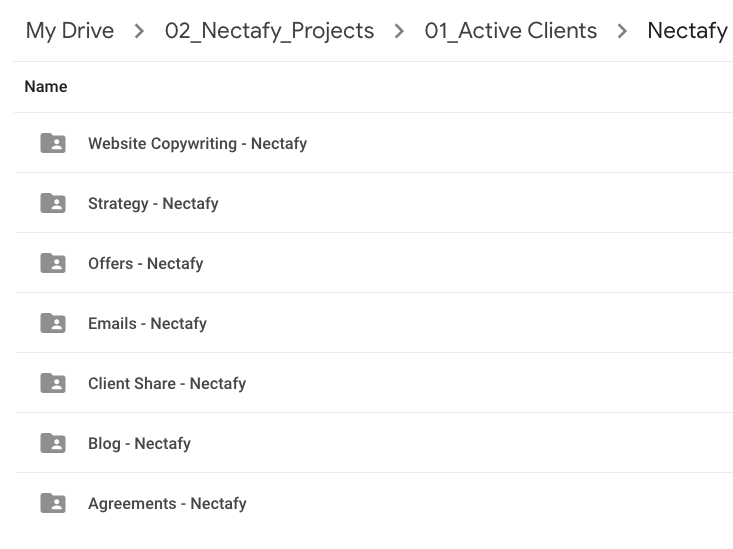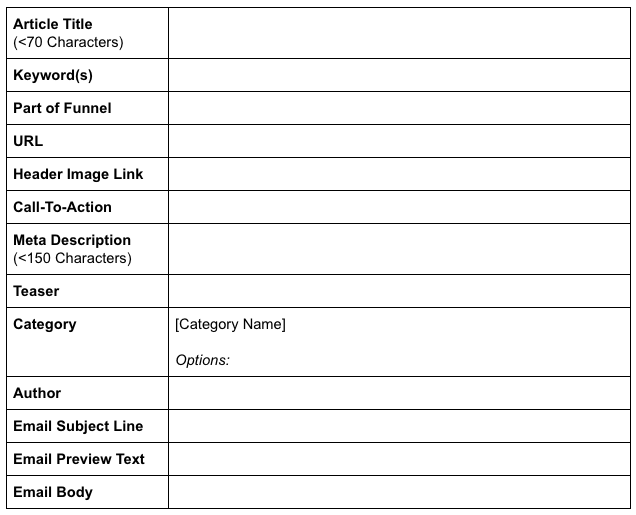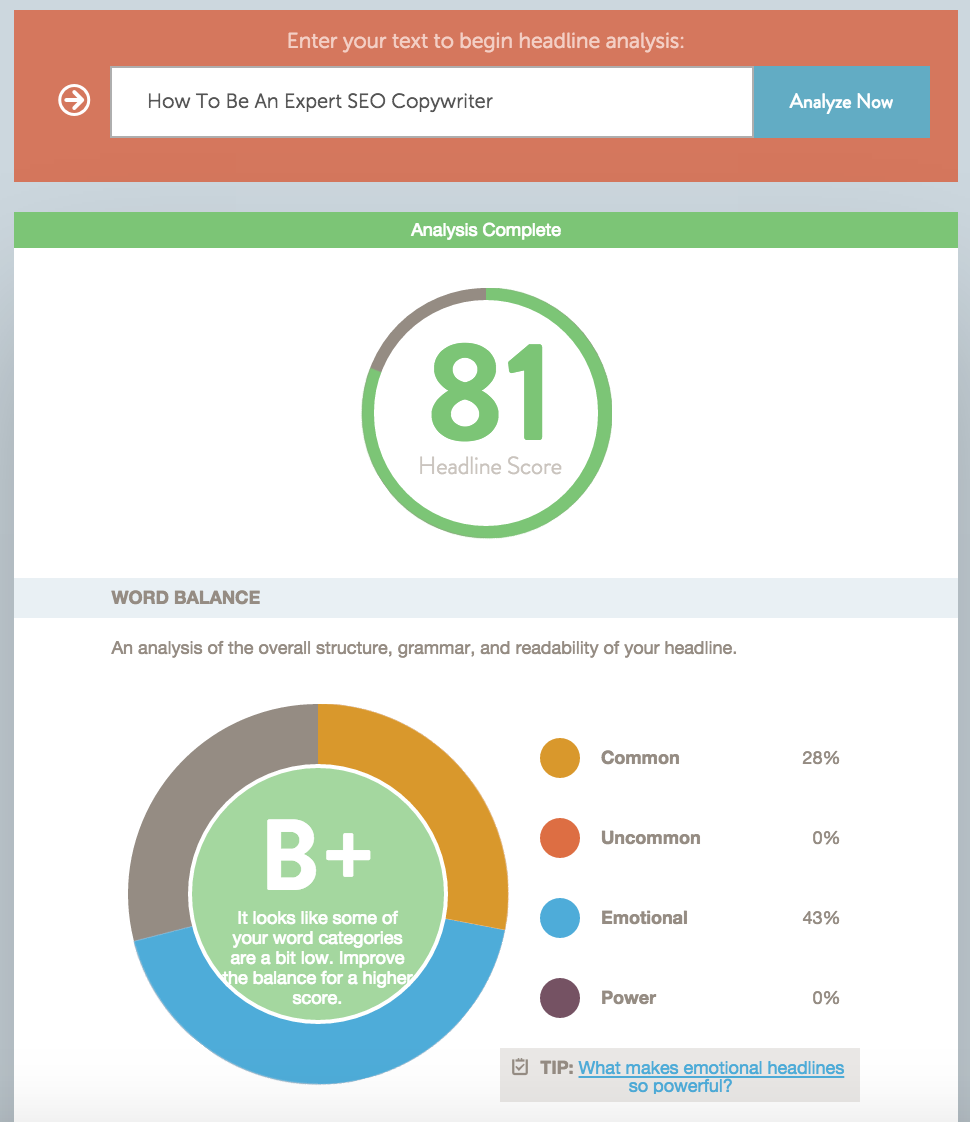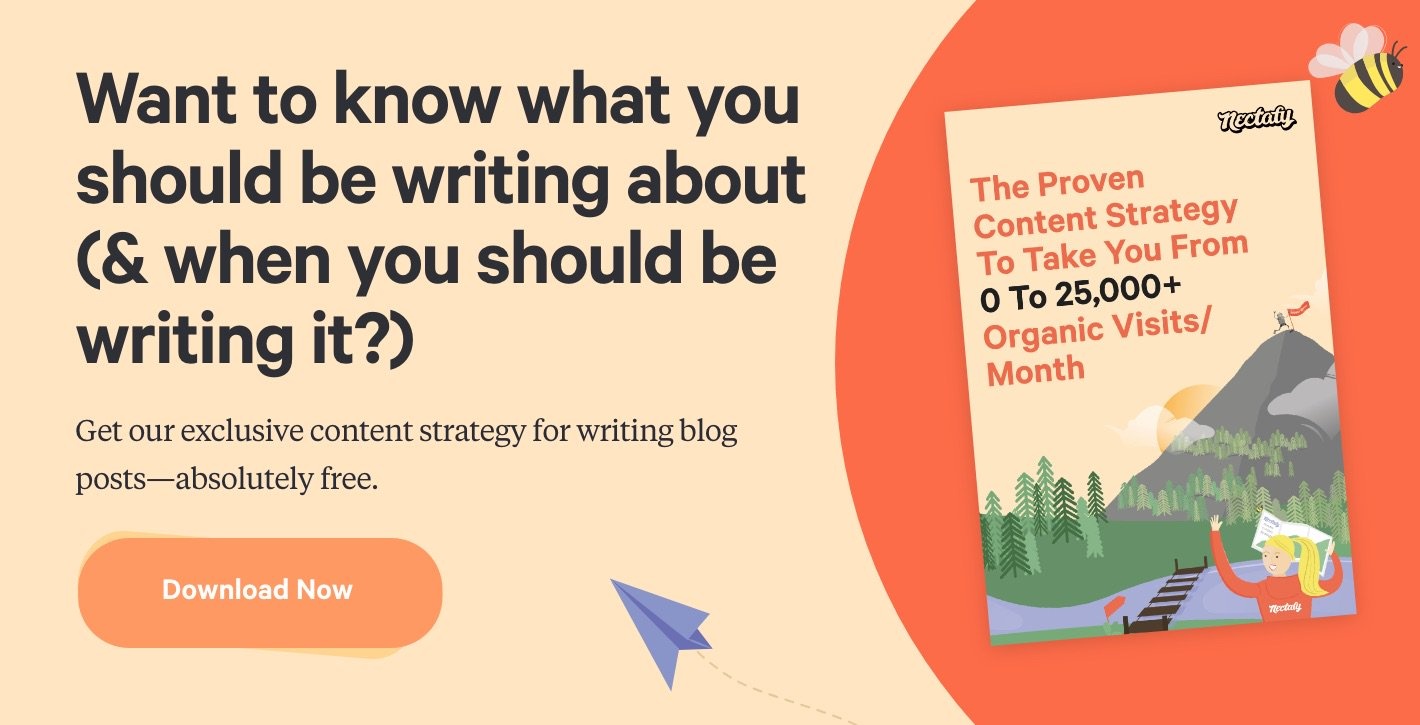Masterful B2B Blogging: The Complete Guide



Table Of Contents
- Chapter 1: How To Start A Business Blog From Scratch
- Chapter 2: Writing Great Content: The Anatomy Of A High-Quality Blog Post
- Chapter 3: How To Write Blog Posts & Collaborate With Google Docs
- Chapter 4: How To Be An Expert SEO Copywriter
- Chapter 5: 5 Foolproof Steps To Staying Consistent With Your Business Blogging
- Chapter 6: 31 Non-Lame Blog Ideas for Business & 1 Really Awful One
- Chapter 7: Are You Committing The #1 Business Blog Writing Faux Pas?
- Chapter 8: How To Outsource Your Business Blog To An Article Writing Service
I’m going on a trip, and I’m bringing…
Have you ever played that game? People come up with the most ridiculous items to haul along, like TVs, hammocks, and even travel trailers. (It doesn’t hurt to dream, right?)
But the point is, when you know you’re about to go on a long trip, you start preparing. You think about every item you’ll need to make the trip a success. You pack clothes, gather snacks, and hopefully find some sort of GPS or map to guide you.
In other words, you don’t just jump in the car without getting prepared first. That would be foolish.
It’s the same way when you decide to start a blog for your company. You know ahead of time that it’s going to be a wild ride full of windy roads and redirects. So it’s a good idea to start planning what you’re going to need, getting the right tools together, and finding the best routes to get where you want to go.
That’s where this article comes in. It’s a collection of the articles we’ve published through the years, all centered around B2B blogging. It focuses on everything from starting a blog to staying organized, with some extras sprinkled in that focus on what you should be posting about. We hope this will give you some direction on how to get your B2B blog up and running, and most importantly, how to utilize it to bring in leads for your company.

Chapter 1: How To Start A Business Blog From Scratch
We have a longstanding joke in my family, and I’m going to share it with you today: I’m not a very good baker.
Several years ago, I tried to make cookies from scratch and ended up adding a cup of milk to the cookie dough. Yikes.
Another time, I misread the directions and added several tablespoons of baking soda. The results were... not so delicious.
The problem is, baking is pretty hard unless you have a good recipe (and, um, in my case, you read it before you start baking). You can have the best ingredients in the world, but if you don’t read and follow the recipe, your end result probably won’t taste so good.
The same thing is true for business owners who decide they want to start a blog “from scratch.” You can have the best team, the best products or services, and the best ideas—but unless you create and follow a plan, the final product won’t be very good and won’t give you the results you’re looking for. (And, in the case of some of my baking, it may have to be thrown out).
Let’s save ourselves a lot of time and trouble and do it right the first time. Here are five things you must do before you decide to start a business blog from scratch.
Step #1: Answer the question, “Why do you want to start a blog?”
Before you go through the time and effort that a (consistent, high quality) blog requires, you need to determine your goals for blogging. For people thinking about writing a business blog, here’s what we think the endgame should be:
- Write helpful, data-driven, insightful, articles that attract people who will buy your product.
- Produce those articles so that the people will read them, find them helpful, and become leads for your business.
You can use those two points to develop the rest of your strategy for blogging with a purpose (instead of just blogging because you think you should).
Hint: The only way your blog readers can become a lead is through specific calls-to-action placed strategically on your website.
Step #2: Figure out who you’re writing for.
The next critical step is to determine the people you’ll be writing your blog for. If you skip this step, there’s no point in continuing (unless, of course, you just want to write a blog for your own entertainment).
Determine Buyer Personas
Figure out who you’re going to talk to who could ultimately buy your product (your leads). These will inform your buyer personas, which are semi-fictional representations of specific people in your target audience who you’ve pinpointed as good potential customers for your product or service. You can learn more about developing your buyer personas here.
Determine Buyer Questions
Find out what questions or issues your buyer personas have about your industry.
- Why are they seeking answers?
- What are they searching for on Google?
- What types of information and resources are they looking for help from?
These will form your buyer questions, which help you determine what your buyer personas are asking in each stage of the buying funnel. You can learn more about asking the right buyer questions here.
Do Keyword Research
You probably know that your website pages (including your blog) need to be optimized in order to rank well on search engines so your customers can find you. This is where keyword research comes in.
Keyword research, the first step in search engine optimization (SEO), is the process of investigating and selecting keywords and key phrases that relate to your business, product, or service. You can help your efforts to bring the right people to your blog by researching which keywords have a greater chance of appealing to them. Take a peek at our article 8 Of The Best Keyword Research Tools For The DIY SEOer to find out how you can use Google Keyword, HubSpot, Keyword Tool, SEO toolbar, and other tools to make the keyword research process a little easier.
Hint: Keyword research isn’t impossible, but it is time-consuming—and in some cases, it may be better for you to partner with an agency to help you get started.
Step #3: Take care of the technical aspects.
For some people, this is the easy part. For the rest of us, it’s helpful to at least understand a little bit of the technical side of a business blog before jumping in feet first. Here are some tips:
- Decide what content management system (CMS) you’re going to go with.
There a lot of things to consider when choosing a platform, and what is right for one company may not be right for another (or for your company). Check out Megan’s article, CMS Comparison: How To Choose Between HubSpot & WordPress, if you want a comprehensive look at two popular CMS options.
- Make sure your blog is on your website.
Some people host their blog on another site—for example, mycompany.wordpress.com—but you shouldn’t. Host your blog on your own website. Why? The hosting site (in this example, WordPress) gets the authority (the credibility that you’re posting good information that makes your website rank higher in Google searches), not your blog.
- Put your blog on a subfolder instead of a subdomain.
Translation: Put your blog on “mycompany.com/blog” instead of “blog.mycompany.com.” Google looks at a subdomain as a slightly separate domain from your main site and thus splits up authority. This way, you don’t have to do double work to build up authority for both the subdomain and your regular website.
Hint: Wondering what’s a good amount to spend on your website? Here’s Lance’s take: How Much Should My Company Spend On A New Website?
Step #4: Delegate responsibilities.
At this point, you’ll need to make some team-driven decisions about your business blog. Start by answering these questions:
Who is going to be the single responsible party?
This point person will be in charge of the blog and making sure all aspects of researching, strategizing, writing, posting, responding to comments, blog maintenance, etc. are taken care of. Keep in mind, this person doesn’t have to do all of these jobs—s/he just needs to know who will do them and when.
Who is going to write content for your website?
Here are some options:
- Create all of the content in-house by splitting it amongst your team.
- Outsource the content creation to an agency.
- Hire freelancers.
- Do a mix of these.
No matter which one you decide, make sure you consider the time aspect of all of these. On average, an article might take you four hours from soup to nuts—that is, from the interview of a subject matter expert, to research, to outlining, to writing, to editing, to posting.
Of course, that number will vary (perhaps greatly) by the skill and the speed of your writer, the complexity of the topic, etc. Still, you can multiply that by the number of blogs you’d like to publish per month to get a ballpark amount of how much time you can expect to spend writing content for your business blog.
Once you see that number, you might realize why it’s so important to make sure your time investment in blogging is panning out in terms of traffic, leads, and eventually, customers.
Read More: How Much Time Doing Inbound Marketing Is Actually Spent In HubSpot? [New Stats]
How are you going to blog consistently?
This one is super important. You need to set a goal for how often you’ll publish a new blog post and then stick to it by creating a content plan and calendar. If you’re only going to publish a blog post once or twice a month, blogging probably won’t be an effective lead generation tool for you.
Step #5: Plan the content.
Start out by answering your buyer questions, writing about things that are being searched by your personas, and writing about things that are being shared via social media.
Here are seven types of articles that are proven to get readers and leads. These articles fall into a number of categories that are proven to attract visitors:
- Keyword-based articles. (Marisa’s article on SEO for startups has four things you can do to quickly earn Google’s trust and help rank a site Google is still warming up to.)
- Persona-based articles.
- Socially enticing articles.
- List articles.
- Articles introducing offers.
- Data-backed articles.
- Bottom-of-funnel articles.
You can check this article to find out more ways to create authoritative content.
Plan out three months of content in advance—this is where you incorporate your strategy for attacking keywords.
Some tips on planning blog content:
- Plan 20-30 articles in advance.
- If you can’t publish at least one article per week, it’s not time to start a business blog yet—it’s going to grow too slowly to bring any value to you. Wait to begin your blog until you’re able to post more frequently.
- Determine when you should post. Overall, visits to our site are 17% higher on days we blog. At Nectafy, blogging on Thursdays has the biggest impact on visits (about 50% more visits than when we don’t blog).While publishing posts on Thursday works for us (according to the data), we’re constantly scrutinizing the numbers to make sure this trend still holds true—and if not, we switch it up. We recommend not posting on Fridays—this article from CoSchedule has some more interesting things you should take into account when planning dates and times you’ll post new blogs.
Bon Appetit!
We have a lot more useful information in our 19,000-word, step-by-step inbound marketing plan. Don’t get nervous about the length—we’ve broken it down so it’s easy to skim through the parts that may be useful to you if you’re starting a business blog from scratch. It’s absolutely vital (and free!) information.

Chapter 2: Writing Great Content: The Anatomy Of A High-Quality Blog Post
Head and shoulders
Knees and toes
Knees and toes...
Eyes and ears and mouth and nose...
This popular children's song helped us all learn the many different parts of our bodies. Too bad there's no such song for the anatomy of a blog post! It'd be much easier in helping us remember all the important elements we should be including every time we write.
We all know that writing great content takes effort—typing up a quick something-or-other and pressing "Publish" doesn't actually make any sort of magic happen (unfortunately!). There are some essential elements that need to be thought-through and in place in order for your post to be found, read, and actually work for your business. So, here are all of the working parts of a high-quality, effective blog post. (Feel free to use this checklist to write your own song. And if you do, make sure you send us a video. We wouldn't want to miss out on that!)
1 A good, solid topic of discussion.
Obviously, before you start writing your blog post, you need to know what you're writing about. This is probably the most important part of the entire process. You can't just choose any old topic—it needs to be the right one.
The whole idea of content and inbound marketing is to write posts that your target audience (or buyer personas, as we call them) can find through their searches on search engines. Therefore, your blog posts should be all about what your buyer personas might be searching for!
Think about it: What problems are your target audience having that you could answer with your industry expertise? (Or what are the problems they're having that you could answer with someone else's expertise?) What helpful tips and advice could you give them about tasks that they do (or would like to do) on a regular basis? What information could you give them that would make their life easier in some way or another? Really, anything your buyer personas would be typing into the Google search bar is fair game.
Hint: It's a great idea to schedule out an allotted period of time just to brainstorm ideas for future blog posts. If you can come up with a list, you won't have to go through this step every time you go to write a post.
2 Thought-through search engine optimization (SEO) check points.
The second element of a high-quality blog post is SEO. Some people want to run the other direction when they hear "search engine optimization," but I promise you, it's really not as complicated as it seems. Here's what you need to do to make sure that your article is searchable.
Choose a keyword phrase that describes the topic you've chosen. You can do this by using tools like Google's Keyword Planner in Google AdWords or a keyword tool within a marketing software (like HubSpot). At Nectafy, we use SEMrush. It gives us a good idea of what people are searching for, and the difficulty level of ranking for that particular search.
Make sure your keyword phrase matches the content in the article you've written. This is really, really important. (You may want to come back to this step after you've written your article, in case it took a turn in another direction after you chose your keyword phrase.) As search engine algorithms change, they continue to become more and more capable of finding articles that are exactly what people are searching for. For businesses, it has become less about SEO "tactics" and "techniques" and more about the quality of the content that they're producing. So, while it's important that the keyword phrase you've chosen appears in some key places (which we'll get to in the next bullet point), it's even more important that your content actually matches the keyword phrase you've chosen and that your post gives the answers that searchers are looking for.
List your keyword phrase (or some variations of it) in all of the following places within your article:
- The title
- The URL
- Within the meta description (see #3)
- A couple to a few times within the body of the content (not too many—that's called "keyword stuffing")
- In the "Alt description" of your image
See? SEO isn't that scary. As long as you have chosen your keyword phrase wisely, written about the subject in a detailed manner, and included your keyword phrases in all those places, you'll be good as gold!
3 An enticing, click-worthy title and meta description.
When your buyer persona finds your article through a search engine, the first thing they'll see is your title. That means your title is what you have to "rope them in." If it's boring, they'll skip right over it. If it doesn't accurately describe the article, it could turn them away. It has to be just right—just what they're looking for.
Jeff Goins (a writer) puts it this way:
“Too often the headline is the most neglected part of writing an article. People just gloss over it without taking much time to consider it. In their minds, it’s the cherry on top. No, friends; it’s not. The headline is the sundae.”
Yikes! The sundae? That means you'll definitely want to put some time and thought into what your article title is going to be.
If your title catches the reader's eye, they'll move on to reading through your meta description. A meta description is the 155 characters that show up underneath the title of your article on a search results page. This is another key opportunity for you to hook the reader, so always write this short description with the intention of giving the reader a reason to click.
4 An eye-catching image.
Just a bunch of words on a page is... just that. It's boring. Once your reader has arrived on your blog post page, there should be something to catch their eye. Having an image that relates to or plays off of your blog post is the perfect thing to keep the reader's eye moving down the page and get them excited about reading your content.
Your image should be high-quality and attention-grabbing—one that makes the reader think just a little (or laugh, even) is great. And the idea of an image is to add to your article—not be a distraction. D Bnonn Tennant says, “If you can’t caption an image, don’t use it.” If your headline isn’t a good caption for the image, rethink your plan.
5 Easy-to-read, descriptive, grammatically correct content.
You know what this is—the point of it all! The body of your post speaks volumes not only about your topic, but about your business as a whole. Ensure you're giving the right impression by making sure these three areas covered:
- Easy-to-read. The average reading level for a blog post should be around eighth grade. So, technically, make sure you aren't saying anything that your buyer persona doesn't understand. Keep things as light as you can with the topic you've chosen. The easier your article is to read and understand, the more your readers will appreciate the information you're giving them.
- Descriptive. Like I mentioned above in #2, you'll want to make sure that you're describing the keyword phrase you've chosen as accurately and as thoroughly as possible. This doesn't mean that your blog post needs to be 2,000 words—it just means that you should be as detailed as you need to be. If your post is getting too long, narrow the focus of your topic, or better yet, split it into multiple blog posts!
- Grammatically correct. This is big when it comes to impressions. Correct spelling, punctuation, and sentence structure will give potential customers and clients confidence in you and your services! It makes you look like you know what you're doing. (Which is always a good thing, right?)
6 A clear call-to-action.
One of the ultimate reasons you've written your blog post is to lead potential customers and clients to your website. Now that you have them there, take advantage of it! Make sure there's a clear call-to-action at the end of each of your posts. You could offer a free guide or a white paper in exchange for the reader's email address, or just simply tell the reader how to take the next step in working with your business. Either way, just make sure you give some kind of next step to the reader. It won't happen if you don't ask!
Your blog posts don't just give readers information—they speak about your business as a whole. They help initiate relationships and start building trust and rapport with potential customers and clients. It's worth it to take the time to make sure that each post is high-quality, engaging, and effective. And including all of the above elements will do just that.

Chapter 3: How To Write Blog Posts & Collaborate With Google Docs
I hated being assigned group projects in my early college days. I usually didn’t know anyone in my group, we could never find time to get together with everyone’s crazy schedules, and nine times out of 10, I ended up doing the majority of the work.
It’s not that I didn’t enjoy working with a team… it was just hard to do.
That is, until my sophomore year, when I had a genius teacher assign a group project through Google Docs. I found out that collaborating on a project actually can be done easily and efficiently. (And my life was forever changed!)
When I found out we would be using Google Docs at Nectafy, I knew it’d be perfect for our digital agency. We believe that writing for inbound marketing should be a team effort, and Google makes it really easy to collaborate on documents—blog posts, specifically—even with our employees working in four different time zones. So if you're looking how to write blog posts when a number of people are involved, this particular process may work for you.
Our Google Docs Process
When we created our Google Docs process (which came about through lots of trial and error) there was one element that we really focused on: consistency. We wanted our clients and employees to have one unified system, since there are lots of people involved in one blog post:
- Writer—interviews key sources for the article and crafts the first draft.
- Graphic Designer—coordinates any images and graphics that need to be included.
- Editor—edits for grammar, voice, and content.
- Client—reviews to add industry-specific information and to make sure it represents the company correctly, then approves of the content.
Here’s what we came up with to make sure all of those people could work together in one document.
First, we created a shared “Nectafy Projects” folder in Google Docs. Every Nectafy employee has access to this folder, and it houses a subfolder called “Active Clients” for each of our company’s projects.
In our Active Clients folder, there are subfolders for every client we currently work with. They are titled with the client’s name, and within each of those folders, there are subfolders for each type of project specific to that client: Offers, Blog, Agreements, Strategy, and more.

Our Blog Template
Each time we create a blog post, regardless of who’s writing it or who it’s for, we use the same blog template, which is located in the Blog folder for each client. This template includes 13 sections:
Title—where the title of the post is written.
Keywords—keyword phrases that go in the post are listed here.
Part of Funnel—we note the stage of the buyer funnel the article is written for.
URL—we write the slug of the article, which is usually a shortened version of the title or the article’s main keyword.
Header Image Link—we make suggestions for the main image in the post and link them here.
Call-To-Action—we list which call-to-action will be included on the web page immediately following the blog post text. We choose the white paper, ebook, webinar, or other offer that fits best with the topic of the blog post.
Meta Description—we write the meta description that will correspond with the post. The meta description is a “teaser” to the article that should be less than 150 characters and include the appropriate keywords. It shows up on the results page of Google (or other search engines) under the title of the post.
Teaser—we write out the teaser text for the post. Some of our client’s blogs have a space for teaser text under the article title on the blog page—it’s just one or two lines “teasing” or describing the article. (It can be similar to the meta description, but it isn’t critical that this teaser text contains keywords, so we have the option of changing it up if we’d like.)
Category—we note which category (or categories) the article will be under on the client’s blog.
Author—the author’s name is included here.
Email Subject Line—here we write the subject line of the article’s corresponding email. (For some clients, we send out an email to notify their subscribers whenever we post a new article. It’s basically a custom-written blog subscriber email.)
Email Preview Text—we add a short blurb summarizing the email and article, usually the length of a meta description. (In fact, we sometimes use the meta description!)
Email Body—the body of the article’s corresponding email is included here. Our content for the blog goes below this template.

Consistency is key!
This is the process and format we use for every blog post. Yes, every single one. It might seem overly-organized or unnecessary, but like I said before, the reason we use such a specific process for our blog writing is for consistency. When collaborating with a team, it’s so much easier to have one working process that everyone understands, and this one works for us. If you’re struggling to collaborate on your blog writing, give this setup a try! It takes diligence at first, but once you have it down, the results are well worth the effort.

Chapter 4: How To Be An Expert SEO Copywriter
Recently, I did a quick Google search of the phrase “SEO writing tips.” To my surprise, almost every article that came up in the results gave some variation of a tip you may have heard before: “Write content for humans, not robots.”
While this is a great tip and 100% true (your content won’t rank well if you only think about pleasing search engines as you write), not one of the articles I read explained exactly how to do that.
I was left asking, “What does it mean to write for humans first and search engines second? How do you do that effectively?”
With those questions in mind, I drew on my writing experience—and the experience of my Nectafy teammates—to create this list of tips, tricks, and tools that will help you find the balance between creating content that is optimized for search engines and content that is pleasing to your human readers.
To start, let’s go over a brief lesson in keyword research. Then, I’ll walk you through my step-by-step article writing process.
A Quick Lesson In Keyword Research
Before you can create content that’s optimized for search engines, you’ll need to have a list of keywords and phrases to use in your copy. You find these phrases by examining your target audience. Think about the people you’re trying to attract with your site’s content, and figure out what “language” they use. When they set out to do a Google search, what words are they going to type into the search bar?
You can find this out by talking to your current customers (or to your salespeople about your existing and past customers). How do they describe your product or service? What terms do they or would they search for to learn more about your industry? Once you have a brainstormed list, you can enter those phrases into Google Adwords Keyword Planner to find exact phrasing and related keyword opportunities.
Pick out the phrases from your research that are most relevant to your target audience—and voila! There’s your list of keywords (and potential blog topics)! As soon as you have that list, you’re ready to write.
My Step-By-Step, SEO Article Writing Process
Whenever I set out to write an article, I always try to have a keyword or phrase in mind before I start. I’ve learned from experience that writing an article without a specific keyword phrase in mind, and then going back to add one in later is much more difficult in the long run. (It can end up chopping up the flow of my piece.) Having the phrase(s) right from the start allows me to form my ideas and structure my sentences around those particular words, which ensures my article flows smoothly and is easy to read.
Once I’ve got a phrase picked out, I’ll start on the title of the post.
The Title
The title of your article is one of—if not the—most important elements of your entire piece. Even if you’ve done an amazing job with SEO, and Google ranks your post number one in the search results, the person behind the computer still has a choice as to whether or not they click on your article. That means you have to spend some time creating an intriguing, attention-grabbing headline—that also happens to include your keyword phrase.
When I write a blog post, I spend several minutes brainstorming title ideas. I try several different headline combinations before, during, and after the post is finished to see where the keyword best fits and to make sure the title is an accurate (and eye-catching) representation of the article.
Use This Tool
A great tool that our Nectafy writers use when creating headlines is CoSchedule’s Headline Analyzer. (In fact, I use it so much that it’s one of the first bookmarks on my browser’s toolbar!)
This blog post headline analyzer tests your title ideas for social sharing, traffic, and SEO value. It will rate your headline on a scale of 0-100 (so you can play around with different wordings to try to increase your score), and it will tell you whether or not you’ve included searchable keywords. And as an added bonus, it will show you what the title will look like as a Google search result and an email subject line. (It’s awesome—we love it!)

The Body
When it comes to the body of your article, it’s important to balance keywords with tone. You want readers (and search engines) to view your post as a credible source of information, so definitely don’t overuse the keyword phrase. We generally stick to keeping the keyword phrase below 2% of the total content, and try to include the first mention of the keyword as close to the beginning of the article as possible. (Oh, and don’t forget to use your keyword phrase at least once in a header!)
Focus on writing helpful information about the keyword. If, in the end, you find that you’ve only used the word two or three times, but have some really great ideas laid out, that’s OK. Both readers and search engines will appreciate helpful content more than content that is “keyword-stuffed” or lackluster.
You should also use related phrases throughout your article. Google tries to match their search results with the intention of the person doing the search (which is a concept called latent semantic indexing), so using synonyms, related keywords, and grammatical variations can make your content more relevant without cramming the exact keyword phrase into the copy too many times.
Links—to both your site and others’ sites—are also important to your SEO. You can mention the keyword phrase in a link’s anchor text, but avoid linking only the keyword phrase when you cite sources. In Google’s eyes, “perfect link text” is a sign of intent to manipulate rankings. So if your keyword is “SEO tips,” it’s better to link to SEO tips like this rather than to link to an article about SEO tips like that.
Use This Tool
Another pretty cool tool that can help with your writing is Cliché Finder. Just copy and paste your article text into their search box and it will analyze your copy for clichés or overused phrases. If you have used a phrase too many times or have used phrases that are completely meaningless (because so many other people use them) it will find and highlight them for you.

The Conclusion
When you get to the conclusion of your article, it’s a good idea to mention the keyword once more, if possible. After I’ve finished a post, I’ll do a quick search of the text (using “Command” or “Control” + “F”) to see how many times I used the keyword, and where and how I used it, and I then make any adjustments needed.

Use These Tools
A tool that helps ensure you’ve optimized your copy for humans rather than search engines is Readability Score. Copy and paste your text into the tool, and it will automatically give you a score from 0-100 based on how easy your content is to read (the higher your score, the easier your content is to read). It will also tell you how easy your copy is to comprehend by giving you a grade level. The lower the grade level, the more people your content will speak to.

Another great tool I’ve recently discovered is nTopic. This site analyzes the relevancy of your content to your chosen keyword. Input a link to the copy you want to test (it must already be published on the web) and the keyword you want to rank for, and it will tell you what percent of your copy is relevant, and give you suggestions on how to update your text to be more on-topic (or nTopic).

Bonus: Other SEO-Important Elements
Wondering about the “behind the scenes” SEO stuff? There are a couple components of a blog post that aren’t obvious to your readers, but will affect your search engine rankings.
The first is the URL (the address at which your article can be found on the web). When creating the URL for your blog post, always include your keyword phrase, and put it as close to the beginning of the URL as possible. It’s also best to cut out any unnecessary words, like adjectives and articles. (Less jargon in the URL will make it easier for people to read, which will make them more likely to trust it.)

Next is the meta description. The meta description is the one- or two-sentence preview text under a search engine search result. It won’t show up anywhere on your actual site, but it's important because it helps entice people to click and read your article. It just provides a little bit more information about your article during a search.
Although it used to be an SEO requirement to include the keyword phrase in your meta description, Google no longer uses that as a ranking factor. However, the click-through rate from Google to your website is becoming an increasingly important factor in how you rank. That means the more people that choose your site over other sites in search results, the more Google will trust you. So it’s important to utilize the meta description and make it as enticing as possible.
Tip: If you do include the keyword phrase in your meta description, Google will bold it in the search results for you. This helps attract people’s attention, since that’s the phrase they searched for. For that reason, I would recommend still including the phrase in the meta description (but don’t worry about it if it sounds too forced).
What About Those Really Tricky Keywords?
I’ll be honest with you—sometimes I look at a keyword phrase I’ve been given and think, “How in the world am I supposed to fit this into an article in a way that actually makes sense?”
When people do Google searches, they aren’t usually thinking about grammar or punctuation (or proper English at all!)—and that can leave you with some pretty interesting keyword phrasing. But, you have to work with what you’re given. That means you may have to do some thinking and be creative in the way you phrase things.
To show you what I mean, here are some examples of a few tricky keyword phrases I’ve come across in my writing and how I’ve worked them into an article.
- “display interactive”: This keyword is tricky because in the context of my article, “display” was the noun being described (like “display”—an “interactive” one), so my tendency was to switch the two words to “interactive display.” While I could do that for a related phrase, I still needed to include it exactly as it had appeared in our keyword research, so instead of using “display” as a noun, I used it as a verb—as in how someone could “display interactive” content.
- “internet of things security challenges”: This particular keyword phrase was difficult for a few reasons. Because the phrase is so long, I knew using it more than a couple of times in an article would quickly become obvious to the reader. Also, “internet of things” is popularly abbreviated “IoT,” so once it’s been written out the first time, it isn’t common practice in the industry to write it out again. In this situation, instead of trying to fit it in (in its exact form) several times, I used it sparingly in the text and took advantage of related words and phrases.
- Any keyword phrase containing an abbreviation of the word “versus”: As Henry stated in one of his articles on SEO strategy, “comparison keywords” are highly effective in SEO. But using a phrase with “vs.” in a grammatically-correct sentence can be difficult and can sometimes sound forced. When given a keyword phrase containing some form of “versus,” I usually end up using a variation of this sentence: “When comparing subject A vs. subject B, you can…” Even though I’d rather use “to” in place of “vs.” there, sometimes you just have to make exceptions! (And while it isn’t grammatically correct to write it that way, it is conversational—so that’s a bonus when you’re writing for humans!)
Be An Expert SEO Copywriter
When it’s all said and done, your readers are who you want to please. So remember that while Google is the one who will ultimately rank your article, there is person behind the search who is looking for helpful, informative content. Write your copy with this in mind, and you’ll quickly become an SEO copywriting expert.

Chapter 5: 5 Foolproof Steps To Staying Consistent With Your Business Blogging
So many businesses hear success stories about content marketing and inbound marketing and get some "momentary motivation" to blog. But, so many times, they either just never seem to get started, or their efforts taper off after just a few weeks.
Why is that? Well, because it's hard. At first.
It seems like a feat in itself just to come up with topics for the first few posts, let alone for the foreseeable future. And it seems impossible to give up even a small amount of time that you feel like you should be spending doing something else that's more productive. But, consistent business blogging can pay off—like crazy.
So, here are some steps to help you start out and stick with it—because consistency is what matters.
1 Fully commit.
There's no such thing as a half-hearted commitment to blogging. (Well, there is, but there's not much of a point to it.) You have to make the commitment to go at it full-force. Like I've said already (and may say 20 times in this post), consistency is the key. A post or two here and there won't cut it. Making half an effort won't get you the results you're counting on—which is the reason you're doing it in the first place.
So, really decide if this is something you want to commit to. We, at Nectafy, would tell you that it's absolutely worth it. But it isn't for the faint of heart. It's going to take work. The good news is that it is work that will pay off. So, if you want to give this a try, don't just plan on dipping your toe in... plan on taking the plunge. Commit to doing it, and doing it right.
2 Make a detailed, achievable plan.
Get with a team and figure out some achievable goals for your business blogging. Here are some questions to ask yourselves:
"Who will be doing the writing?"
First and foremost, decide who will be responsible for writing. How many people on your current team are able to handle that responsibility? Remember, it doesn't necessarily need to be someone who has all the "knowledge." You just need good writers—they can interview the necessary people for the information they need.
Also, how many people can you find on the team that are able to write? The more people that are available, the less responsibility each individual has, which makes blogging more doable. The more writers you have, the more articles you can turn out.
"How many times a week will we post?"
Obviously, the more often you post, the quicker you're going to see results. But you only have the capacity for so much with your current team. And, remember, quality is important. So decide what that means for your company and choose that magic weekly number carefully. And definitely don't over-commit. You can always add a post or two per week later on.
"What will we be writing about?"
Before you start writing anything, determine who your target audience is. Figure out the problems and questions that your customers and potential customers are asking. What are they Googling? What do they need help with? Remember, above all, the content you create should add value to your industry.
It's tempting to want to talk about your products and services in your blog posts and make that the topic of discussion. But, fight the urge. You'll get a better, more positive response if you stick to giving potential customers knowledge about the industry and answers to their questions instead of being sales-pitchy with your product.
"What are our expectations?"
What are your business blogging goals? What do you expect to get out of it? An increase in website views? By how much? When are you hoping to achieve your goals? Be specific in what you're trying to accomplish.
The more detailed your plan is, the easier it will be to carry it out.
3 Set reminders.
Once you have a weekly schedule down of when you're posting and who's writing it, set calendar reminders for yourself and your other writers so that no one can forget to post. And, never ever fall into the trap of "Oh, I'll just do it tomorrow." Consider your due dates final. Every day you push a post, the less likely it is that you're going to finish it. So, plan on getting every post up on time.
4 Don't settle for less than the plan you created.
You've made a plan, so stick with it! Embrace it as a part of your regular weekly routine, and it'll soon become like second nature to you.
If you decide within the first few weeks that you've absolutely committed to too much, reconvene with your team and alter your plan—but just slightly. Remember that the more you post, the faster you'll see results, so don't cut your post number down too much.
5 Reap the benefits.
If you're consistently turning out high-quality content, you will see results. Make sure you're tracking and measuring your progress. Without it, you won't know if what you're doing is actually working.
The great thing about analytics is that you can view how each individual article performs. (Especially if you're using a platform like HubSpot.) You'll begin to see which posts are the most popular and which aren't, which in turn tells you what your customers are wanting. This will allow you to start tweaking your approach. And fine-tuning your plan will only help your conversion rates go up.
Stick to these steps and business blogging will become like second nature to you.

Chapter 6: 31 Non-Lame Blog Ideas for Business & 1 Really Awful One
If you're taking content marketing seriously, you already know how easy it is to feel stuck trying to figure out blog ideas for your business. I'm no stranger to that feeling. In fact, to be brutally honest, that's where I found myself this week. So, I wrote this list of blogging ideas to help me get un-stuck.
Now, after I wrote this list, I did a little searching and found out that there are several other lists out there for blogging ideas for business. The issue, though, is that for your blog to be effective in converting customers, you need to always write with your customer in mind. That means that we can eliminate quite a few options that you might use if you were just blogging for personal delight.
With all of these ideas, think customer first. Putting yourself in the place of your customers is one huge way to write stuff they care about.
Each time you post to your business blog, be sure to answer the question, "So what?"
31 Genuinely Helpful Ideas For Your Next Business Blog Post
- Answer a common customer question. The way you would address it in person.
- Compare two products or services that you sell. Use A vs. B.
- Teach your customer "How To" do something that you know. Use photos or video if you can.
- Write a list of ideas for a favorite business-related topic to help your customer. (Yep. Like this one.)
- Interview someone in a different industry that might help your customers. Here's one I did like this: Lifetime Value of a Customer.
- Introduce one of your team members to your customers. No corporate speak, though. Just introduce a friend to a friend.
- Give your real opinion on a trend in your industry. Say what needs to change. Be your customer's advocate.
- Write a "just because" post about a newly popular topic, and ask for your customer's opinion.
- Excerpt a news article about something in your industry and add your opinion. Guide your customer through that article.
- Write a "Thank You" post to a customer.
- Brag on a customer that has done something really well with your product or service. Do this often.
- Share a favorite product that your company doesn't sell. What other products do you love?
- Evaluate a typical customer problem, and then show a solution.
- Talk about a principle or character trait that you admire in someone. Keep it real.
- Do a "behind the scenes" walk-through of your company.
- Create a "Top 10" list. Or a "10 Worst" list. Don't take yourself too seriously.
- Interview a customer.
- Write about one way that you are different from your competition, and how that helps your customer.
- Share links to 5 articles that you believe would help your customer. Provide a link, and then a brief paragraph why you suggested it.
- Tell about a lesson you learned about business. Give credit where credit is due.
- Write about some future plans for your business. How are you working hard to help your customer in the future?
- Celebrate a company success. Just don't brag. Make sure you tell the customer why that means something to them.
- Write a brag about the community where your company is located. Why is it a great place for business?
- Recognize a leader in your community who has made a difference. Be generous.
- Ask for feedback about a new product or even better, ask them to help you choose between two ideas. Dangerous. And profitable.
- Use a popular phrase. Just for kicks, use Google Keyword Tool to find a phrase that's important to your business, and see how creative you can be with it. See how many variations of that phrase you can use in your post without sounding like a robot. Just kidding. If you're going to use Google Keyword Tool, make sure that you have something worthwhile to say about the topic. You know, something that helps your customer.
- Use other's inspiration. Take a post that you like, make an outline of the main points. Then write your own post from that outline. That's not plagiarism. That's being smart.
- Share something funny that has no tie at all to your company. Just every now and then, if it's something your customer might think is funny.
- Refer others. Point your customers to another person's site who can help them with other needs. Chris Brogan did this. I think it was also wonderfully illustrated in the movie Miracle on 34th Street.
- Explore a philosophical question that drives your business. Get brainy. But keep it where your customer understands and sees the value in it.
- Jump on the bandwagon. Check out what the latest rage is, and throw your $.02 in on how it affects your company. Probably should keep it light, though. Otherwise your customers will think you're obsessed. And weird.
One Really Awful Idea for Your Business Blog
- Hire an SEO company that just "writes content" for your blog without caring about the value for your customers. Lame & pathetic. (Ask me how I really feel, sometime...)
Alright, you speak up. What are some other ideas you've seen or put into practice on your blog?

Chapter 7: Are You Committing The #1 Business Blog Writing Faux Pas?
When I think of faux pas, dinner table etiquette typically comes to mind. Specifically, I love thinking of movies that highlight these little blunders—the 1997 Titanic film has some good ones.
Jack Dawson fumbles his way through a first-class dinner, looking for cues from helpers Rose and Molly Brown. It’s amusing to see the looks he conjures from others at the table with his conversation and how he goes about eating his meal. Rose’s mother, Ruth, shoots some especially scathing (and humorous to us!) looks across the table at his lack of manners.
Just as there are "dinner table faux pas," there is one main "business blog faux pas" floating around that you may be unaware of. Are people shooting you scathing looks from across the web?
Don’t be that person.
We all know people like "that person." You know, the one that just goes on and on about him- or herself? (One or two people have already come to your mind, I'm sure!) It’s really quite annoying. Their lives may be wonderful and they may do all kinds of exciting things, but unfortunately for them, no one cares to listen to people talk incessantly about themselves.
Guess what? The same thing goes in the business world—no ones wants to hear about you either.
For crying out loud—stop talking about yourself!
The biggest business blog writing faux pas you can make is to write about yourself—about how awesome and amazing your products and services are, about what you’re experiencing or doing as a company... over and over and over again... (Save all this information for an “About” page or your product pages instead!)
I apologize if this comes across as harsh! (It can be a blow to the ego at first.) But, I'm really just trying to help—no one is really interested in frequently reading about what your business is up to. (Just like you don’t care to listen to that person brief you on their life’s latest highlights.)
You probably already knew this deep down. You’re not in business to cater to your interests and needs. You're in business to cater to your customers.
So, what should you write about?
The answer is pretty simple.
Take a look at your buyer personas and your target audience. What interests them? What are their needs? What challenges are they coming up against? What questions do they want answered?
Step into their shoes. What kind of questions are they asking? What topics are they researching and reading about? Schedule out a time to figure out the answers to these questions and then brainstorm content ideas that will answer their questions and resonate with their needs.
Do you notice a common theme? Your content should be all about what is going to be meaningful to your audience—what is going to be valuable to them.
Shine the spotlight on your audience.
When you begin writing for the needs and desires of your target audience, you’ll never commit that terribly embarrassing business blog writing blunder ever again. You’ll know exactly what your audience wants to read and will be confident in delivering just that. So, get to know your audience and make your business blog writing all about them.
They’ll thank you, and you’ll like the results, too.

Chapter 8: How To Outsource Your Business Blog To An Article Writing Service
If there’s one thing we’ve learned about effective content marketing, it’s the importance of your business’s blog. Your blog is one of the absolute best ways to attract customers and get your information out there, but writing posts can be quite time consuming, especially when you want to post multiple times each week and are doing all (or most of) the writing yourself. Luckily, there are a few solutions to this problem—one of them is outsourcing your blog to an article writing service.
What’s An Article Writing Service?
Basically, an article writing service is a business you hire to write your blog posts for you. There are several different professional services out there (Zerys, Scripted, and TextMaster to name a few) and they allow you to choose a writer from their large pool of employees—someone who you feel would be a good fit for you and your company. Many sites allow their writers to create profiles that display their credentials and areas of expertise, so you are able to pick someone who knows about your particular service or product and who will write to your company’s standards.
How Do They Work?
In most cases, article writing services will let you choose a writer, then, based on your needs, let you give them the topics, style, and keywords you would like used. The writers generally have experience creating content for SEO, so they should give you articles that use relevant keywords or phrases and contain unique content that provides important information about your specialty. (If they don’t give you content like this, you need to find a writer who will.)
Some sites, like Upwork, will even let you post particular jobs you need done and will let qualified writers apply for the position, whether it’s a one-time gig, a part-time job, or a full-time writing position. Each writing service has their own process, so pricing varies from site to site.
What Are Some Things To Consider When Hiring One?
There are several things to think about before you choose an article writing service. Since all are different, it’s important to do your research first.
How often do you want to post?
The frequency in which you plan to publish articles to your blog will help you determine who to hire. If you’re trying out the whole outsourcing thing for the first time, you may just want to start out with a one-time post to get a feel for it. Then, if you find a writer you like working with, you may want to create a schedule with them putting out two articles per week, four articles per month, etc.
How much are you willing to pay?
Most of the time, article writing services are cheaper than hiring a full time in-house writer. They usually have different levels of writers, meaning some have more experience than others. Less experienced writers are generally cheaper, and more experienced writers more expensive. So, your budget will have to depend on the quality of writing you want and can afford. Each site is different, so they may even have a base rate that doesn’t depend on the writer. If you do some research, you should be able to find something that will work within your company’s means.
How involved in the writing process do you want to be?
Some services are very open and let you communicate with the writer as much as you want. Others have a stricter policy. If you want to be able to proof the article, send it back for revisions if necessary, and have a good amount of say in the entire process, you’ll need to find a writing service that allows this kind of open communication. If you’re wanting them to make posts on a regular basis without having to be overly involved in the process, make sure you find a writer that you can trust to produce high-quality content without your constant supervision. (Although you should still give your input every now and then, because it’s still your blog.)
Do you want a specialist or a generalist?
There are writers that specialize in a specific niche, and there are those with strong writing skills and the ability to write for many different topics when necessary. Choosing a writer will depend on how deep your content needs to go on a particular topic. If you go into a lot of specific detail in your posts, then you’ll probably want someone with experience in that field, or someone who is willing to delve into research and learn the ins and outs of your industry.
Choose The Best Service For You
If you’ve decided that it’s time to outsource your business’s blog to an article writing service, make sure you take everything into consideration. Choosing a service is completely based on your company’s needs, so make sure you take the time to find someone who will ultimately meet those needs and create the best content for you.

Conclusion
We hope this collection of articles got the wheels turning for you! Whether you’re just starting a B2B blog or you’ve been doing it for years, it’s never too late to change direction and head where you’ve always wanted to go. It just takes planning and perseverance. (And a roadmap, of course. Check out the articles below for more guidance on how you should be utilizing your blog for the best results.)
- The Proven Content Strategy If You Have <1000 Organic Visits/Month
- The Proven Content Strategy If You Have 1,000 to 25,000 Organic Visits/Month
- The Proven Content Strategy If You Have 25,000+ Organic Visits/Month
If you have any questions or just want to chat, set up a time to talk here. We’d love to get a conversation going.
